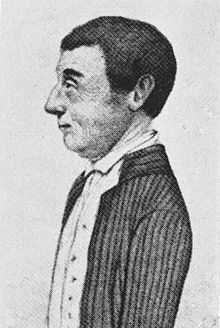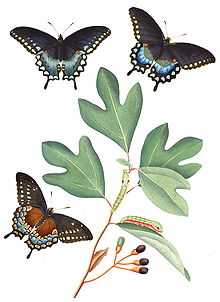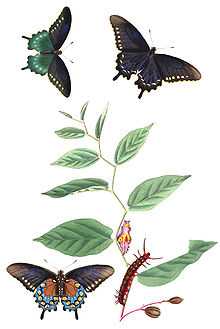John Abbot (entomologist)
| John Abbot | |
|---|---|
 John Abbot, self-portrait | |
| Born |
31 May or 1 June 1751 London, England |
| Died |
December 1840 or January 1841 Bulloch County, Georgia |
| Nationality | English |
| Fields | |
John Abbot was an American entomologist and ornithologist. He was born on 31 May or 1 June 1751 in London and died on December 1840 or January 1841 in Bulloch County in Georgia.
Life
Little is known of his life. He was the eldest son of James Abbot and Ann Clousinger. His father was training him to become a lawyer,[1] but Dru Drury encouraged his interest in entomology and art[1] and he studied drawing and engraving with the engraver Jacob Bonneau (1741—1786). Dru Drury and a group of naturalists from the Royal Society, recognized his talent as an illustrator, and encouraged him to go to Virginia to study and collect natural history specimens. He remained in Virginia from 1773[2] to 1775, and then settled in Georgia in what is now known as Screven County.[2] He served in the Revolutionary War in the Third Georgia Continental Battalion as a private.[1] As a veteran after the war he received several hundred acres of land upon which he established a plantation, and became the local school master.[1]
He produced thousands of insect illustrations, as well as several sets of bird illustrations. The majority are preserved in the Natural History Museum, London, the British Museum and Houghton Library at Harvard University. Other repositories of his drawings include Johns Hopkins University, University of South Carolina, Emory University, and the Alexander Turnbull Library. Some have been dispersed following various auctions that included his drawings. The bird and insect specimens that he collected were sent to Britain and Europe, but a certain number were lost at sea, which discouraged him. He nonetheless continued to collect and paint specimens until at least 1835.
The only publication to bear his name was The Natural History of the Rarer Lepidopterous Insects of Georgia, whose primary author was James Edward Smith. It included 104 plates that were reproduced from original drawings by John Abbot, which are now preserved at Johns Hopkins University. Abbot also provided most of the observations published in the book. First appearing in 1797, new copies of the book were issued for thirty years.
From 1829 to 1837, renowned French entomologist Jean Baptiste Alphonse Dechauffour de Boisduval (1799–1879) and wealthy American naturalist John Eatton Le Conte (1784–1860) published installments of Histoire Générale et Iconographie des Lépidoptères et des Chenilles de l’Amérique Septentrionale. This publication included 78 hand-colored engraved plates, most created from original drawings by John Abbot. The majority of these original drawings are now deposited at the University of South Carolina. A collection of 130 watercolors of birds, are held by the Smithsonian Institution.[3]
Works
- with James Edward Smith, The Natural History of the Rarer Lepidopterous Insects of Georgia Collected from Observations by John Abbot (1797) (2 volumes, 104 plates).
- Drawings of the Insects of Georgia, in America (1792–1804) (17 volumes, unpublished).
- Original drawings for Jean Baptiste Alphonse Dechauffour de Boisduval's and John Eatton Le Conte's Histoire Générale et Iconographie des Lépidoptères et des Chenilles de l’Amérique septentrionale (1833).
Plates from Rarer Lepidopterous Insects of Georgia
References
- ↑ 1.0 1.1 1.2 1.3 Capinera, John L. et al., eds. (2008). "Abbott, John". Encyclopedia of Entomology 1. Dordrecht: Kluwer Academic Publishers. p. 2. doi:10.1007/978-1-4020-6359-6_3. ISBN 978-1-4020-6242-1. Archived from the original on 21 January 2014.
- ↑ 2.0 2.1 "Abbot, John, 1751-1840, John Abbot Collection". Record Unit 7116. Smithsonian Institution Archives. Retrieved 28 March 2012.
- ↑ "John Abbot Collection, undated". Smithsonian Institution Archives.
Sources
- Arnold Mallis (1971). American Entomologists. Rutgers University Press (New Brunswick) : xvii + 549 p.
- Calhoun, J. (2004). Histoire Générale et Iconographie des Lépidoptères et des Chenilles de l’Amérique septentrionale by Boisduval and Le Conte (1829-[1837]): original drawings used for the engraved plates and the true identities of four figured taxa. Journal of the Lepidopterists' Society 58:143-168.http://images.peabody.yale.edu/lepsoc/jls/2000s/2004/2004-58(3)143-Calhoun.pdf
- Calhoun, J. (2006). A glimpse into a 'flora et entomologia': The Natural History of the Rarer Lepidopterous Insects of Georgia by J. E. Smith & J. Abbot (1797). Journal of the Lepidopterists' Society 60:1-37.http://images.peabody.yale.edu/lepsoc/jls/2000s/2006/2006-60(1)1-Calhoun.pdf
- Calhoun, J. (2006). John Abbot's "lost" drawings for John E. Le Conte in the American Philosophical Society Library, Philadelphia. Journal of the Lepidopterists' Society. 60:211-217.http://images.peabody.yale.edu/lepsoc/jls/2000s/2006/2006(4)211-Calhoun.pdf
- Calhoun, J. (2007). John Abbot's butterfly drawings for William Swainson, including general comments about Abbot's artistic methods and written observations. Journal of the Lepidopterists' Society. 61:1-20.http://images.peabody.yale.edu/lepsoc/jls/2000s/2007/2007(1)1-Calhoun.pdf
- Calhoun, J. (2007). The butterfly drawings by John Abbot in the Hargrett Rare Book and Manuscript Library, University of Georgia. Journal of the Lepidopterists' Society. 61:125-137.http://images.peabody.yale.edu/lepsoc/jls/2000s/2007/2007(3)125-Calhoun.pdf
- Calhoun, J. (2007). Butterfly drawings by John Abbot in the Houghton Library, Harvard University, that are wrongly attributed to an inferior copyist. Journal of the Lepidopterists' Society. 61:228-232.http://images.peabody.yale.edu/lepsoc/jls/2000s/2007/2007(4)228-Calhoun.pdf
- Calhoun, J. (2013). Remarks about the life and death of John Abbot (1751-c.1840). Southern Lepidopterists' News. 35:44-52.
- Calhoun, J. & D. Johnston (2010). John Abbot, the English naturalist-artist in Virginia. Banisteria. 35:3-10.http://virginianaturalhistorysociety.com/banisteria/pdf-files/ban35/Banisteria%2035_ABBOT%20IN%20VA_color-A.pdf
- Hollingsworth, D. (1989) (ed.), The History of Screven County, Georgia (Dallas, Tex.: Curtis Media Corporation).
- Keir B. Sterling, Richard P. Harmond, George A. Cevasco & Lorne F. Hammond (dir.) (1997). Biographical dictionary of American and Canadian naturalists and environmentalists. Greenwood Press (Westport) : xix + 937 p.
- Gilbert, P. (1998). John Abbot: birds, butterflies and other wonders. Merell Holberton (London): 128 p.
- Rogers-Price, V. (1983). John Abbot in Georgia: the vision of a naturalist artist (1751-ca.1840). Madison-Morgan Cultural Center (Madison, Georgia): 149 p.
- Rogers-Price, V. (1997). John Abbot's birds of Georgia: selected drawings from the Houghton Library Harvard University. Beehive Press (Savannah): xlii + 26 pl.
| Wikimedia Commons has media related to Lepidopterous Insects of Georgia (Abbot). |
External links
- Author Query Results and Plant Name Query Results for John Abbot (entomologist) at the International Plant Names Index. Retrieved on March 26, 2008.
- Works by or about John Abbot in libraries (WorldCat catalog)
- Guide to John Abbot's works at Houghton Library, Harvard University
|


